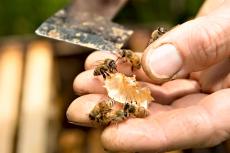Big Reed Pond in Montauk is beset with a bloom of toxic cyanobacteria, or blue-green algae, and the southern end of Fort Pond, also in Montauk, is at high risk of a bloom, according to Concerned Citizens of Montauk, citing testing conducted by the Gobler Lab at Stony Brook University’s School of Marine and Atmospheric Sciences. Fort Pond as a whole is at medium risk of a bloom.
Fort Pond has experienced cyanobacteria blooms every summer since 2015, with the exception of 2016. Cyanobacteria is also blooming in the Georgica Cove section of Georgica Pond in East Hampton. Georgica Pond, where a dog died after ingesting water from it in 2012, has been fouled with cyanobacteria every summer since that incident.
A level of cyanobacteria in Big Reed Pond was measured at 107.96 micrograms per liter this week. Levels above 20 micrograms per liter and above indicate a high risk of bloom and trigger toxicity testing. The New York State Department of Environmental Conservation considers a concentration of 25 micrograms per liter and above a bloom.
Testing during the week of June 22 revealed a cyanobacteria level of 49.96 micrograms per liter in Big Reed Pond. The level had fallen slightly during the week of July 13, spiked to 207.21 micrograms per liter two weeks later, and fallen to 34.55 micrograms per liter in the first week of August.
“There was a huge jump from no bloom/low risk to a confirmed bloom on June 24,” Kate Rossi-Snook of C.C.O.M., which in 2018 partnered with the Gobler Lab to monitor harmful algal blooms in Fort Pond, said in an email on Friday. She described it as “a strange globular cyanobacteria that seems to only appear in Big Reed.”
In partnership with the Surfrider Foundation’s Blue Water Task Force, C.C.O.M. tests and analyzes water bodies in Montauk, Amagansett, and East Hampton for enterococcus, a bacteria that exists in the guts of warm-blooded animals. High levels of enterococcus are considered a risk to human health. The phenomenon is often due to heavy rain, extreme high tides, and/or warm water temperatures.
“Continued dry weather seems to be resulting in decreasing bacteria levels for now,” Ms. Rossi-Snook said. Nonetheless, high levels were measured in the Lake Montauk’s East Creek and in a southerly section. Medium bacteria was measured at the ramp in Fort Pond and in the creek at Fresh Pond in Amagansett. High bacteria was also measured at the culvert in Northwest Creek in East Hampton, at the shipyard ramp at Accabonac Harbor, and in Pussy’s Pond in Springs. A medium bacteria level was measured at Folkstone Drive in Three Mile Harbor.
Testing will continue weekly through the summer.



